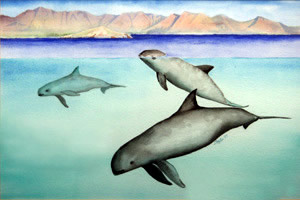
Mexico's vaquita is the world's most-endangered marine mammal
In response to the urgent need to save the vaquita porpoise, the governments of Canada, Mexico and the United States asked the Commission for Environmental Cooperation (CEC) to formulate a strategy to support Mexico's efforts to recover the world's most-endangered marine mammal.
Today, the CEC launched the North American Conservation Action Plan (NACAP) for the Vaquita (Phocoena sinus), a vital cooperative initiative that is the result of contributions from scientists, academics, environmental groups and officials in the three countries.
The vaquita is critically endangered and its population is estimated at only about 150 individuals. Unless concrete conservation actions are taken, the effective size of the population—individuals capable of reproduction—may fall to just 50 adults in the next two years.
The main and most immediate threat to the vaquita's survival is their incidental capture in fishing nets, such as gillnets and drift nets. About 40 vaquitas are estimated to die each year from incidental capture.
Though the vaquita only inhabits the waters of the Upper Gulf of California, in Mexico, the three countries in North America consider it to be a species of common continental concern.
One of the greatest challenges in the integration of the plan has been to link conservation efforts with the well-being of the fishing communities of San Felipe, Golfo de Santa Clara and Puerto Peñasco. The document lists a series of priority actions aimed at finding economic alternatives for local residents and, especially experimenting with vaquita-safe fishing methods. With international cooperation, the efforts already begun by the Mexican government can be strengthened.
"The objective of the recovery efforts is for people who make their living from fishing to see the vaquita as an opportunity for economic and social well-being, and not a threat to their future," explained Adrián Vázquez-Gálvez, executive director of the CEC. "In the end, only with the support of Upper Gulf communities can we achieve vaquita recovery and the conservation of the region's marine resources as a whole."
The actions spelled out in the vaquita plan seek to ensure, on one hand, the survival of the species, and on the other, the sustainability of the communities in the Upper Gulf.
Together with research, monitoring and assessment of the vaquita population, a key aspect of the plan is the creation of awareness with respect to the current status of this endangered cetacean and its importance within the ecosystem.
This plan, along with seven others previously released, forms part of the trinational effort to foster the conservation of endangered marine and terrestrial species of common concern in North America. The conservation of each NACAP species is vital to maintain the integrity and health of the ecosystems it inhabits.
